Stephanie A. Mann's Blog, page 15
February 22, 2024
Preview: St. Thomas More on God's Grace and the "World"
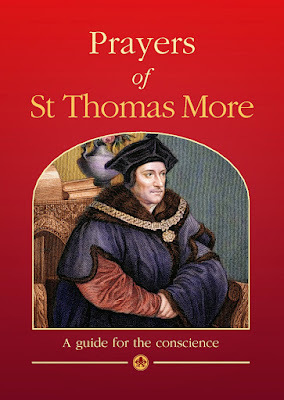 On Monday, February 26, we'll continue our series on St. Thomas More's "A Godly Meditation" on the Son Rise Morning Show. I'll be on at our usual time, about 7:50 a.m. Eastern/6:50 a.m. Central. Listen live here or catch the podcast later.
On Monday, February 26, we'll continue our series on St. Thomas More's "A Godly Meditation" on the Son Rise Morning Show. I'll be on at our usual time, about 7:50 a.m. Eastern/6:50 a.m. Central. Listen live here or catch the podcast later.We're going to begin with the prayer itself after our general introduction last week to More's circumstances and plan for his life and death in the Tower of London. Now we'll begin to see how applicable his plan is to our Lenten practices of fasting, almsgiving and prayer. Here are the lines for this conversation:
Give me thy grace, good Lord,
To set the world at naught.To set my mind fast upon thee and not to hang
Upon the blast of men’s mouths.
To be content to be solitary,
Not to long for worldly company.
Little and little utterly to cast off the world
And rid my mind of all the business thereof.
Give my thy Grace, good Lord; More begins in the right place, asking God's grace to accomplish his plan of life. I think that's where we should begin too. "Oh God, come to my assistance. Make haste to help me." We can't do this on our own, saving ourselves, manifesting our own willpower to achieve these ends. Whatever we set out to do or not to do, we have to discern that it's what is best for us to do, with God's grace, and then ask for His grace to help us persevere with our Lenten discipline so it transforms us by the end of the season, prepared for the Holy Triduum and Easter Sunday!
His first petitions introduce the negative and positive aspects of his preparation, and ours:
To set the world at naught.To set my mind fast upon thee and not to hang
Upon the blast of men’s mouths.
First to treat the world as nothing of importance; to become detached from the world. How do we do this?
Like Thomas More, husband, father, and friend, diplomat and author, former Speaker of the House of Commons, Lord Chancellor, if we're active laity, we have to be involved in the world in many ways, in our families, workplaces, our cities, states, and country. We can't abandon it.
I think he offers two ways to face this challenge:
First, setting our minds fast upon the Lord, through prayer, spiritual reading, silence, and all the different ways Catholic tradition has given us. That's part of any Christian life, intensified during Lent.
Second, to avoid the "blast of men's mouths", the cacophony of talk and endless speculative debate. Perhaps not reading or listening to all the "talking heads" on television and radio discussing politics or sports to no consequence? When I heard some sports talk still discussing the Super Bowl two weeks after the event, debating who lost the game for the 49ers, I thought, how useless! They've got to fill the hours, but I don't have to listen or watch.
In the following lines, perhaps the first part ("To be content to be solitary,/Not to long for worldly company.") applies most directly to More's situation in the Tower of London, but the last part can apply to us as we try to "Little and little utterly to cast off the world/And rid [our minds] of all the business thereof", especially when it's not really our business . . .
I'm sure Matt or Anna will have other responses and suggestions . . .
Saint Thomas More, pray for us!
February 15, 2024
Preview: St. Thomas More's "A Godly Meditation": A Guide for Lent
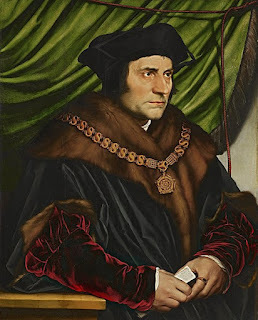 For February 19 and 20 in his Mementoes of the English Martyrs and Confessors For Every Day of the Year (and he does include an entry for February 29 during a Leap Year!), Father Henry Sebastian Bowden chose one of the prayers Saint Thomas More wrote in the Tower of London. Some sources date this prayer to sometime in 1534 (More was imprisoned on April 17, 1534; he was tried on July 1, 1535 and executed on July 6), as he began his life in prison.
For February 19 and 20 in his Mementoes of the English Martyrs and Confessors For Every Day of the Year (and he does include an entry for February 29 during a Leap Year!), Father Henry Sebastian Bowden chose one of the prayers Saint Thomas More wrote in the Tower of London. Some sources date this prayer to sometime in 1534 (More was imprisoned on April 17, 1534; he was tried on July 1, 1535 and executed on July 6), as he began his life in prison.Since Saint Thomas More spent the last months of his life, as he said, meditating on the Passion of Christ and preparing himself for death, I thought it could make a good guide for the Lenten Season.
Therefore, on Monday, February 19, Anna Mitchell or Matt Swaim and I will start our discussion of this great prayer on the Son Rise Morning Show, continuing to reflect on its riches each Monday of Lent 2024.
I'll be on at our usual time, about 7:50 a.m. Eastern/6:50 a.m. Central. Listen live here or catch the podcast later.
Father Bowden titles the two entries, on pages 63 and 64, "In the Shadow of Death" (1) and (2) with the final verse from the Benedictus, "To enlighten them that sit in darkness and the shadow of death" and "To direct our feet into the way of peace" divided between them. (Luke 1:79)
For our first episode, we'll just review the issues More is dealing with in this prayer: all that he's lost and all that he hopes to gain. The entire text is a litany of petitions. As he wrote this in the margins of his breviary Thomas More was preparing himself for death, either in prison or by execution. He had already lost his freedom, his influence, his power, his friends, and many of the comforts of his family and he was praying to be reconciled to those losses. I don't think this was easy for Saint Thomas More: Although the petitions seem measured and calm, More was facing a great struggle.
Here is the text as Father Bowden presents it:
"In the Shadow of Death" (1)
Give me thy grace, good Lord,To set the world at naught.
Note: you may see these first two lines written at the top and bottom of a page from More's breviary here.
To set my mind fast upon thee and not to hang
Upon the blast of men’s mouths.
To be content to be solitary,
Not to long for worldly company.
Little and little utterly to cast off the world
And rid my mind of all the business thereof.
Not to long to hear of any worldly things,
But that the hearing of worldly fantasies may be to me displeasant.
Gladly to be thinking of God,
Piteously to call for his help.
To lean unto the comfort of God,
Busily to labour to love him.
To know my own vility and wretchedness,
To humble and meeken myself under the mighty hand of God.
To bewail my sins past
For the purging of them patiently to suffer adversity.
Gladly to bear my purgatory here;
To be joyful of tribulations.
"In the Shadow of Death" (2)
To walk the narrow way that leadeth to life,
To bear the cross with Christ.
To have the last thing in remembrance,
To have ever afore mine eye my death that is ever at hand.
To make death no stranger to me,
To foresee and consider the everlasting fire of hell.
To pray for pardon before the Judge come,
To have continually in mind the Passion that Christ suffered for me.
For his benefits incessantly to give him thanks,
To buy the time again that I before have lost.
To abstain from vain confabulations,
To eschew light foolish mirth and gladness.
Recreations not necessary to cut off;
Of worldly substance, friends, liberty, life and all To set the loss at right naught for the winning of Christ.
To think my most enemies my best friends, for the brethren of Joseph could never have done him so much good with their love and favour as they did him with their malice and hatred.
Father Bowden does not include this final line in these two entries:
[These minds are more to be desired of every man than all the treasure of all the princes and kings, Christian and heathen, were it gathered and layed together all upon one heap.]
Saint Thomas More starts out preparing to lose much that he held dear; then he prays for what he needs not just to replace but to surpass those things; then he meditates on preparing for death and repenting of past sins--then he mentions again all the things he needs to give up and what he'll gain thereby. As Father Bowden concludes the prayer, More wants to be grateful, even, to those who've put him in the Tower of London, comparing his situation to the story of Joseph in the Old Testament.
Finally, More compares worldly treasures to spiritual goods, with the latter far surpassing the former.
Each Monday of Lent, we'll discuss More's " A Godly Meditation" as a pattern for Lent, as it serves as a model of detachment, repentance, and faith in God. Some of the things More gave up may easy for some of us, or as hard or harder for some of us as they were for him, but what he stood to gain--"the comfort of God" and "the winning of Christ" are as precious to us as they were to him.
Saint Thomas More, pray for us!
February 8, 2024
Preview: The End of Shrovetide/Mardi Gras/Carnival/Fasching on the Son Rise Morning Show
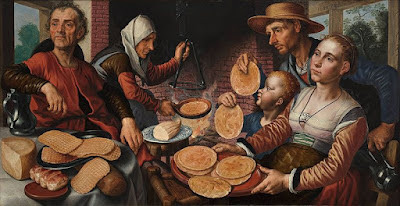
In order, from the title: Shrovetide in England/Mardi Gras in Louisiana/Carnival in parts of Europe/Fasching in Germany; not to mention the Liturgical pre-Lenten season of Septuagesima! These are all different names for the lead-up to Lent, which was at least partially a practical matter of emptying out the larder of meat and meat by-products before the very strict Lenten period of fasting and abstinence.
On the Son Rise Morning Show on Monday, February 12, we'll talk about Shrovetide and the Pancake Races held in England and in Liberal Kansas (!): the background for Pancake Day and free short stacks at various locations in the USA! I'll be on at our usual time, about 7:50 a.m. Eastern/6:50 a.m. Central. Listen live here or catch the podcast later.
Here is a good source for a description of Shrovetide and Shrove Tuesday:
Shrove Tuesday is the last day of what traditionally was called "Shrovetide," the weeks preceding the beginning of Lent. The word itself, Shrovetide, is the English equivalent for "Carnival," which is derived from the Latin words carnem levare, meaning "to take away the flesh." (Note that in Germany, this period is called "Fasching," and in parts of the United States, particularly Louisiana, "Mardi Gras.") While this was seen as the last chance for merriment, and, unfortunately in some places, has resulted in excessive pleasure, Shrovetide was the time to cast off things of the flesh and to prepare spiritually for Lent.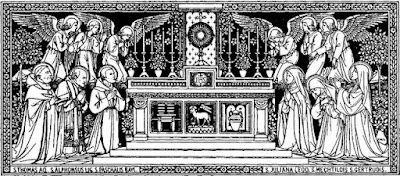
That excessive merriment and pleasure--that is, gluttony and drunkenness--is the reason that some churches started the tradition of the Forty Hours Devotion (Quarant'ore in Italian) leading up to Ash Wednesday, from the last Sunday of the Septuagesima "season", Quinquagesima, through Tuesday. Instead of partying, Catholics were encouraged to adore the Blessed Sacrament in the Monstrance.
Actually, the English term provides the best meaning for this period. "To shrive" meant to hear confessions. In the Anglo-Saxon "Ecclesiastical Institutes," recorded by Theodulphus and translated by Abbot Aelfric about AD 1000, Shrovetide was described--as follows: "In the week immediately before Lent everyone shall go to his confessor and confess his deeds and the confessor shall so shrive him as he then may hear by his deeds what he is to do in the way of penance." To highlight the point and motivate the people, special plays or masques were performed which portrayed the passion of our Lord or final judgment. Clearly, this Shrovetide preparation for Lent included the confessing of sin and the reception of absolution; as such, Lent then would become a time for penance and renewal of faith.
While this week of Shrovetide condoned the partaking of pleasures from which a person would abstain during Lent, Shrove Tuesday had a special significance in England. Pancakes were prepared and enjoyed, because in so doing a family depleted their eggs, milk, butter, and fat which were part of the Lenten fast. At this time, some areas of the Church abstained from all forms of meat and animal products, while others made exceptions for food like fish. For example, Pope St. Gregory (d. 604), writing to St. Augustine of Canterbury, issued the following rule: "We abstain from flesh, meat, and from all things that come from flesh, as milk, cheese, and eggs." These were the fasting rules governing the Church in England; hence, the eating of pancakes on Shrove Tuesday.
And the eating of bacon on Collop/Shrove Monday!
Here is a recipe for pancakes from the Tudor era: specifically, from The good Huswifes Handmaide for the Kitchin from 1588:
To make the pancakes:
Take new thicke Creame a pinte, four of five yolks of Egs, a good handful of flower, and two or three spoonfuls of ale, strain them altogether into a faire platter, and season it with a good handful of Sugar, a sooneful of Synamon and a little Ginger: then takea frying pan, and put in a little peece of Butter, as but as your thombe, and when it is molten browne, cast it out of your pan, and with a ladle put to the furthesr side of your pan some of your stuffe, and hole your pan aslope, so that you stuffe may run abroad all ouer all the pan, as thin as may be: then set it to the fyre, and let the fyre be verie soft, and when the one side is bakes, then turne the other, and bake them as dry as ye can without burning.
After one Tudor housewife starting making her pancakes, she heard the church bells ring and ran to church, carrying the frying pan with a pancake in it, still wearing her apron, and tying a scarf around her head--and that's how the tradition of Pancake Races began. Since 1950, ladies in Olney, England and Liberal, Kansas (USA) have competed in the International Pancake Day races!
February 2, 2024
Book Review: "Cradle of Redeeming Love" by John Saward
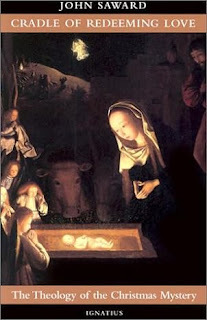 Just in time for Candlemas, I finished this book by John Saward, Cradle of Redeeming Love: The Theology of the Christmas Mystery. I had read it almost a decade before, and both times I've read the Ignatius Press paperback edition. Now it is published by Angelico Press, with a similar cover image and similar cover blurb:In Cradle of Redeeming Love, John Saward returns to the mystery of Christ’s incarnation and birth. Drawing upon both the rich traditions of the Church and the writings of the great Christian mystics, he fashions a work both new and old, revolutionary and orthodox. This profoundly moving meditation on the meaning of the Incarnation will enrich any contemplation on the life of Christ.
Just in time for Candlemas, I finished this book by John Saward, Cradle of Redeeming Love: The Theology of the Christmas Mystery. I had read it almost a decade before, and both times I've read the Ignatius Press paperback edition. Now it is published by Angelico Press, with a similar cover image and similar cover blurb:In Cradle of Redeeming Love, John Saward returns to the mystery of Christ’s incarnation and birth. Drawing upon both the rich traditions of the Church and the writings of the great Christian mystics, he fashions a work both new and old, revolutionary and orthodox. This profoundly moving meditation on the meaning of the Incarnation will enrich any contemplation on the life of Christ.The subject of this book is the “Christmas” dogma: the divinely revealed truth of the Nativity of Christ, as proclaimed by His infallible and immaculate Bride, the Church. It is the splendor of this truth, of “Love’s noon in Nature’s night,” which for two millennia has captivated the minds of Fathers and Schoolmen, activated the genius of poets, painters, and musicians, and, in even the bleakest of mid-winters, brightened the eyes of little ones kneeling by the Crib.
And also, as our Greater Wichita G.K. Chesterton group continues to read The Everlasting Man (also for the second time as group, but with different members), I must note how often Father Saward quotes and references Chesterton throughout the book. There are also a few mentions of Saint John Henry Newman, but the theologian and saint quoted most often is Saint Thomas Aquinas, whose feast (though superseded by Sunday! as we know Saint Thomas would think entirely fitting!) was January 28, opening Catholic Schools week. Other saints and theologians frequently cited are Pope St. Leo the Great, Saints Ambrose of Milan, Augustine of Hippo, Bernard of Clairvaux, Bonaventure, Cyril of Alexandria, and Jerome, etc. In addition to Chesterton, Father Saward also cites another Englishman, Father Frederick Faber of the London Oratory, especially Faber's book Bethlehem: The Sacred Infancy of Our Most Dear and Blessed Redeemer.
What impressed me most this reading was Father Saward's emphasis in Chapter One, "How great the mystery!" The Mysteries of the Life of Jesus, that every act of Jesus's life on earth was an act for our salvation: not just (!) His Passion, Death and Resurrection, but every act from His Infancy and through His active ministry: every teaching, every healing, every rejection--everything the Incarnate Son of God did on earth was for our salvation. Not just for our moral improvement, doctrinal instruction, or our spiritual development, but for our salvation.
From page 78-79 in the Ignatius press edition:
But the mysteries of the life of Jesus are more than just a series of dogmatic instructions and moral lessons. They provide not only a model for outward imitation but also a source of inward transformation. . . . they sanctify us by an efficient as well as an exemplary causality; they not only show us how to be holy in the likeness our Saviour but reproduce that likeness in our souls. From the fleshly birth of the Head comes the spiritual rebirth of the members. When the divine Messiah takes on the Old Law at His Circumcision, He lifts the burden from other men. The immersion of His body in the Jordan gives a new sacramental vocation to water. His victory over Satan in the wilderness strengthens His faithful against temptation. His Passion saves us my merit, satisfaction, sacrifice and redemption. His Resurrection from the tomb is the source and model of our own resurrection, in soul and in body. "Redemption," says the Catechism [of the Catholic Church], "comes to us above all through the blood of his cross, but this mystery is at work throughout Christ's entire life." [517] As Pope Pius II [in Mediator Dei, no. 163], in each mystery, Christ is the 'Author of our salvation.'
I think this knowledge should make a great difference in the way I read or, especially, hear the Gospels proclaimed at Holy Mass!
As a good friend of mine said, who finished the book before Christmas, this is a book to read again and again--probably more often than every ten years!
February 1, 2024
Preview: Margaret Powell, Recusant Catholic Confessor
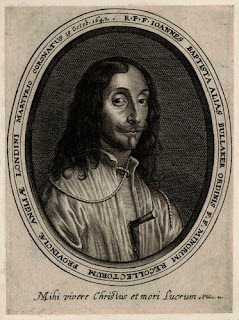 Among the beatified and canonized English martyrs, there are only several women (Saints Margaret Ward, Margaret Clitherow, Anne Line, and Blessed Margaret Pole), but there are many whom Father Henry Sebastian Bowden would call Confessors. In his daily Mementoes of the English Martyrs and Confessors, he highlights one such Confessor, Margaret Powell, who was arrested, tried, and sentenced to death in 1642 for aiding and abetting Blessed Thomas Bullaker, OSF, one of the 85 Martyrs of England and Wales beatified by Pope John Paul II. So on Monday, February 5, we'll continue our series on the the Son Rise Morning Show by remembering this brave woman.I'll be on at our usual time, about 7:50 a.m. Eastern/6:50 a.m. Central. Listen live here or catch the podcast later.
Among the beatified and canonized English martyrs, there are only several women (Saints Margaret Ward, Margaret Clitherow, Anne Line, and Blessed Margaret Pole), but there are many whom Father Henry Sebastian Bowden would call Confessors. In his daily Mementoes of the English Martyrs and Confessors, he highlights one such Confessor, Margaret Powell, who was arrested, tried, and sentenced to death in 1642 for aiding and abetting Blessed Thomas Bullaker, OSF, one of the 85 Martyrs of England and Wales beatified by Pope John Paul II. So on Monday, February 5, we'll continue our series on the the Son Rise Morning Show by remembering this brave woman.I'll be on at our usual time, about 7:50 a.m. Eastern/6:50 a.m. Central. Listen live here or catch the podcast later.Father Bowden titles her entry for February 6 (p. 48) "The Sunamitess Rewarded" with this verse from 2 Kings 4:8: "now there was a great woman there, who detained him to eat bread; and as he passed often that way, he turned into her house to eat bread." Margaret Powell is the "great woman"; Blessed Thomas Bullaker the prophet Elisha; the bread is the Holy Mass in Bowden's analogy.
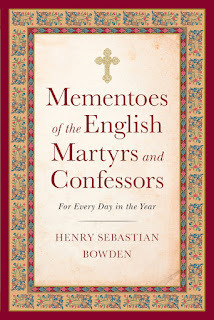 As he describes her, Margaret Powell was "of good birth," but "reduced to great poverty through her sufferings for the Faith." Like Saint Margaret Clitherow, she was married to a Protestant, but still ministered to priests in prison, and often had one visit their home to say Mass. In October 1642, Father Thomas Bullaker "was seized while saying Mass, and Margaret and her boy, aged twelve, who was serving the Mass, were taken with him".
As he describes her, Margaret Powell was "of good birth," but "reduced to great poverty through her sufferings for the Faith." Like Saint Margaret Clitherow, she was married to a Protestant, but still ministered to priests in prison, and often had one visit their home to say Mass. In October 1642, Father Thomas Bullaker "was seized while saying Mass, and Margaret and her boy, aged twelve, who was serving the Mass, were taken with him".One of the sources Father Bowden mentions in his introduction is "Mrs. Hope's Franciscan Martyrs". Mrs. Anne Hope's Franciscan Martyrs in England was published in 1878; she was convert to Catholicism after studying Church History and moved to Edgbaston to be close to Saint John Henry Newman at the Birmingham Oratory (are you surprised?) She provides these details about Margaret Powell (p. 140):
M. de Marsys, a gentleman in the household of the Comte d'Harcourt, the French ambassador, tells us that this lady was Margaret Parkins, the wife of Mr. Powell, a Protestant. She was about thirty years of age, and though connected with the principal families of England, was reduced to great poverty by the constant persecutions which she suffered for the cause of God. She had an only son whom she educated with great care in the Catholic faith. She devoted herself to prayer, fasting, and good works, especially to waiting upon priests who were ill in the prisons, gladly shutting herself up with them, and nursing them with such care and liberality that even the most hardened heretics could not but admire her extra- ordinary virtue.
Mrs. Hope also provides Father Bowden these comments about her behavior at trial (p. 150):
One of the judges, who was a Puritan, exhorted her to think of her soul and her family, and to embrace the religion of the kingdom instead of giving her life for papistical superstitions. But she answered, smiling, that "as soon as the Parliament should have made choice of a religion they might invite her to receive it; as at the present moment they were disputing on it among themselves, it was ridiculous to make such a proposal to her." Her eloquence, her modest and courageous bearing, and her presence of mind touched even the Protestants who were present. The judges, therefore, finding that they drew from her only disagreeable truths and repartee which exposed them to the laughter of the bystanders, sent her back to prison. British History Online has some detail about the indictments of Father Bullaker and Margaret Powell (though the dates don't match Father Bowden's timeline):
August 31: Also record of the arraignment &c. of Thomas Bullaker for being a catholic priest; and also of Margaret Powell, for receiving and harbouring the said Thomas Bullaker (pro hospitacione Tho. Bullaker). Against the name of Thomas Bullaker appears this minute "non vult directe respondere nec se super patriam ponere, Ideo consideratum est quod predictus Thomas Bullaker trahetur super hurdellam usque furcas de Tiborne et ibidem suspendetur et vivens ad terram prosternatur, quodque interiola et membra sua e corpore suo abscindentur et in conspectu comburentur, quodque caput ejus abscindetur, et corpus ejus in quatuor partes dividetur, Et quod corpus et quarteria ejus ponantur ubi Dominus Rex assignare voluerit."—Against the record of Margaret Powell's arraignment appears the memorandum "po se Repr usq' prox sine ball" = She puts herself 'Not Guilty' on a jury of the country, and is reprieved without bail till next Session.—In the record of the proceedings of the next Session, viz., of 7 December, 18 Charles I., appears this memorandum, "Itt is thought fitt and soe desired by this Courte that Mr. Serjeant Phesant doe attende the House of Lords to acquainte theire Lordships with the proceedings against one Margarett Powell, convicted for the felonious receivinge Thomas Bullaker a Popishe Priest (who was executed the last Session) knowinge him to bee soe, And to knowe theire Lordships' pleasure whether shee shall bee executed according to the judgment given against her or be reprieved." G. D. Reg.
Thus, Father Bullaker was condemned to being hanged, drawn, and quartered at Tyburn in great Latin detail and Margaret, representing herself, pled not guilty and was bound over for trial. A later entry further notes:
September 11: True Bill that, at St. Sepulchre's London co. Midd. on the said day, Thomas Bullaker late of the said parish clerk, born within the kingdom of England, and after the Feast of St. John the Baptist, 1 Eliz., and before the said 11 Sept., 18 Charles I., made and ordained "Sacerdos anglice a Seminarye Preist" by authority derived and pretended from the See of Rome, was and remained &c.; and that, at St. Sepulchre's London co. Midd. on the said 11 Sept, 18 Charles I., knowing him to be a priest of such kind as is abovesaid, Margaret Powell late of the said parish spinster received, harboured, comforted and maintained the said Thomas Bullaker. The clerical note over Thomas Bullaker's name at the bill's head is, "Nihil dic' Judiciu' qd. trahetur suspendetur et quartiatur videlt.' At the bill's foot appears the usual record in full of the sentence for execution at Tiborne, in the manner prescribed for the execution of felons, convicted of high treason. A note over Margaret Powell's name shows that at a subsequent Session, held on 7 Dec, 18 Charles I., she was found 'Guilty' and sentenced to be hung. G. D. R., 5 Oct., 18 Charles I.
Blessed Thomas Bullaker was executed at Tyburn on October 12, 1642, but according to Father Bowden's memento, Margaret Powell was not hanged as sentenced (evidently Parliament ordered her reprieved in December 1642). Bowden comments on her reaction:
At her trial, she had "expressed her joy at the prospect of laying down her life for the Faith in which she had been born, and which she hoped with God's mercy to bear unspotted to the grave." When she heard that her "sentence was deferred, she burst into tears; yet quickly recovering herself, she offered her new lease of life to God as obediently as she had accepted death."
Whether she remained in prison for the rest of her life or was released, the record does not say--nor could I find out the fate of "her boy, aged twelve." But we might remember that the reward of the Sunamitess was the life of her son, miraculously conceived although her husband was old and miraculously restored to life by the Prophet Elisha (2 Kings 4:16-37)
Blessed Thomas Bullaker, pray for us!Margaret Powell, rest in peace! (and pray for us!)
January 29, 2024
Book Review: "Flannery O'Connor's 'Why Do the Heathen Rage?'"
 Last Friday I watched the repeat of
The World Over
on EWTN (the 1/26/2024 episode; about the 41:26 mark) and saw Raymond Arroyo interview Jessica Hooten Wilson discussing this book and her efforts to understand what Flannery O'Connor was trying to write about in what would have been her third novel, Why Do the Heathen Rage?
Last Friday I watched the repeat of
The World Over
on EWTN (the 1/26/2024 episode; about the 41:26 mark) and saw Raymond Arroyo interview Jessica Hooten Wilson discussing this book and her efforts to understand what Flannery O'Connor was trying to write about in what would have been her third novel, Why Do the Heathen Rage?So after attending Adoration and Mass at the Newman Center (St. Paul's University Parish) at Wichita State University, I went to Eighth Day Books to purchase one of the copies stacked on the table on the first floor. The book is published by Brazos Press of the Baker Publishing Group and the full title is: Flannery O'Connor's Why Do the Heathen Rage? A Behind-the-Scenes Look at a Work in Progress. The publisher provides the Table of Contents on their website:
Introduction
Why Do the Heathen Rage? The Porch Scene
Koinonia
Sequel to "The Enduring Chill"
Why Do the Heathen Rage? Walter's Last Will and Testament
Why Do the Heathen Rage? Baptism
Why Do the Heathen Rage? Walter/Asbury's Childhood
Why Do the Heathen Rage? Walter Recites the Ten Commandments
Epistolary Blackface
Why Do the Heathen Rage? The Black Double
Maryat Lee and Oona Gibbs
Documenting "Real" Life
Why Do the Heathen Rage? Photo Journal
The Revolting Conversion
Why Do the Heathen Rage? Do Not Come, Oona Gibbs!
Introducing the Girl
Why Do the Heathen Rage? The Girl
Who Is Oona Gibbs? Mother, Daughter, Aunt, Cousin, or Lover
Why Do the Heathen Rage? Walter's Aunt
Burning Crosses
The Violent Bear It Away: The Burnt Cross
Why Do the Heathen Rage?
One Potential Ending
The Other Half of the Story
Afterword by Steve Prince
Just a reminder that I have read another of JHW's books, Giving the Devil His Due: Demonic Authority in the Fiction of Flannery O’Connor and Fyodor Dostoevsky, which I reviewed here. She has visited Wichita twice to speak at Eighth Day Institute events, once at the Inklings Festival and once at a Symposium. She is now the Fletcher Jones Endowed Chair at Pepperdine University.
This is a very personal book: there's quite a bit of JHW in the book: her first interest in Flannery O'Connor because she was encouraged to take her as a model for writing fiction as a Christian; her participation in the 2009 International Flannery O'Connor Conference in Rome; her visits to Milledgeville and the Georgia College & State University Special Collections; her familiarity with O'Connor's short stories; her efforts to understand O'Connor's last years and struggle to create this third novel. This is what she works to communicate to the reader. This book might be read as a follow-up to her defense of Flannery O'Connor after Paul Elie not only accused O'Connor of Racism, but even asked “How Racist Was Flannery O’Connor?” in a 2020 New Yorker essay. JHW even repeats her analysis of the short story "Revelation" in that First Things article on pages 172 through 174 in this book.
The book is sympathetic to O'Connor's struggles and takes care to place her in her historical and cultural context: the post-Gone With the Wind South at the beginning of the Civil Rights Movement. I use that historical marker because Margaret Mitchell's sentimental novel and David O. Selznick's even more sentimental movie of the novel (JHW highlights the movie's opening titles: "land of Cavalier and Cotton Fields" . . . "pretty world [where] Gallantry took its last bow" . . . "a Civilization gone with the wind") repulsed O'Connor: she did not want to write another book like that! See pages 157 through 161. Her oeuvre, which I think we should always grant to the writer, is to explore the eternal spiritual truths that infuse temporal, human, and fallen issues and actions.
I think this book succeeds in its purpose: to explore an artist's efforts to try something new (JHW emphasizes that O'Connor wanted to depict a different kind of revelation, of conversion and the change that comes over a person's life because of that conversion, in Why Do the Heathen Rage?) and even the issues of her own milieu and life (including a fatal illness) that hampered those efforts. As I read the book I thought of Arthur Hugh Clough's poem, usually titled "The Struggle":
Say not the struggle nought availeth,The labour and the wounds are vain,
The enemy faints not, nor faileth,
And as things have been they remain.
If hopes were dupes, fears may be liars;
It may be, in yon smoke concealed,
Your comrades chase e'en now the fliers,
And, but for you, possess the field.
For while the tired waves, vainly breaking
Seem here no painful inch to gain,
Far back through creeks and inlets making,
Comes silent, flooding in, the main.
And not by eastern windows only,
When daylight comes, comes in the light,
In front the sun climbs slow, how slowly,
But westward, look, the land is bright.
January 25, 2024
Preview: "Catholics are . . . not papists but Christians" (Cardinal Müller)
The headline for an exclusive Q&A interview with Cardinal Gerhard Müller begins with the quotation "The Catholic Church is not the Pope’s Church and Catholics are therefore not papists but Christians" as an edited pull quote from a longer sentence in the Cardinal's response to the second question ("What has the Church traditionally taught on the limits of papal authority? ")
. . . The approach to a Catholic ecclesiology is important. In Lumen Gentium, Vatican II did not begin with the Pope because, contrary to what traditional Protestant polemics believed, the Catholic Church is not the Pope’s Church and Catholics are therefore not papists but Christians. Christ is the head of the Church and from Him all divine grace and truth passes to the members of His body, which is the Church. This is also what Vatican II says with the highest authority in the Dogmatic Constitution on Divine Revelation Dei verbum (Art. 10). (emphasis added0Papist is a pejorative term for Catholics: it was commonly used through the long English Reformation and even used when Parliament began passing Acts allowing Catholics more religious freedom (cf ,The Papists Act of 1788, 18 Geo. 3. c. 60). Therefore, I found it interesting that Cardinal Müller used a term so associated in my mind at least with the English Reformation and the long-lasting fear of and prejudice against Catholics in England and her Colonies.
Cardinal Müller is denying that Catholics have ever been Papists. This pejorative term, traditionally used by Protestants against Catholics does not reflect true Catholic identity, according to his answer. We are Christians, not Papists. We should not let others define our identity, based on sixteenth century Protestant tradition handed down through the centuries.
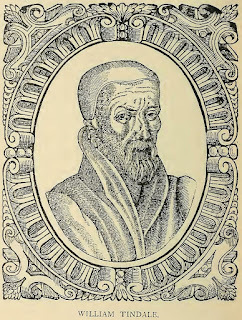 Its first use as a noun in England occurred in 1528 (as in, "He is a Papist") according to
Merriam-Webster
; as an adjective in 1562 (as in, "He has Papist loyalties").
Its first use as a noun in England occurred in 1528 (as in, "He is a Papist") according to
Merriam-Webster
; as an adjective in 1562 (as in, "He has Papist loyalties"). In 1528, William Tyndale had written and published The Obedience of the Christian Man, which advocated Caesorapapism (the monarch's control of the church in his realm) and the Divine Right of Kings. Anne Boleyn persuaded Henry VIII to read the book and he was influenced by it. In 1532, the Convocation of Bishops agreed to the Submission of the Clergy, abdicating their rights to make ecclesiastical laws to the king and Sir Thomas More resigned as Lord Chancellor, because he would be responsible for enforcing the laws Henry VIII made.
The opposition cited by this term by English Protestants was between the English monarch (Henry VIII, Edward VI, Elizabeth I, James I, Charles I, etc., etc.) and the pope at the time (many popes, from Clement VII, to Pope St. Pius V, to Gregory VIII, to Leo XI, to Blessed Innocent XI, etc., etc.): the issue was: what divided loyalty between secular ruler cum supreme governor of the Church of England and the Pope, the Vicar of Christ, could be allowed on either side?
When Pope St. Pius V excommunicated Queen Elizabeth I and took the further step of declaring English Catholics not bound to loyalty to their monarch (in belated support of the Northern Rebellion) in 1570 (Regnans in Excelsis), he merely intensified the conflict. His successor, Pope Gregory XIII tried to dial it back by separating loyalty and obedience to the Papacy and the Catholic Church in religious matters from loyalty to the monarch and country in civil matters. Although Queen Elizabeth stated that she wanted no window into men's souls, she still wanted their total loyalty, body and soul.
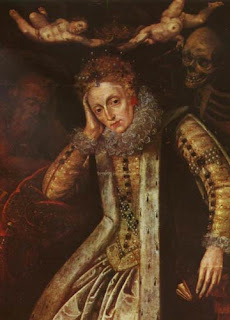 The Appellants late in Elizabeth I's reign tried to reach an agreement with the queen on the grounds of those separate loyalties, and James I also tried to craft a compromise, but the conflict of loyalties remained. An emblem of these failures would be the martyrdom of Blessed Robert Drury: he was one of the signers of the loyal address of 31 January 1603 which acknowledged the queen as lawful sovereign on earth, but maintained their loyalty in religious matters to the Pope. After the Gunpowder Plot discovery, James I required the Appellants to sign a new oath which acknowledged his authority over spiritual matters. Robert refused, and was arrested in 1606 for the crime of being a priest. He was offered his freedom if he would sign the oath; he declined. Martyred by being hanged, drawn, and quartered on 26 February 1607 at Tyburn, London England. He--and Blessed Roger Cadwallador, another former Appellant signatory, martyred on 27 August 1610--is one of the Eighty-five Martyrs of England and Wales beatified by Saint Pope John Paul II in 1987.
The Appellants late in Elizabeth I's reign tried to reach an agreement with the queen on the grounds of those separate loyalties, and James I also tried to craft a compromise, but the conflict of loyalties remained. An emblem of these failures would be the martyrdom of Blessed Robert Drury: he was one of the signers of the loyal address of 31 January 1603 which acknowledged the queen as lawful sovereign on earth, but maintained their loyalty in religious matters to the Pope. After the Gunpowder Plot discovery, James I required the Appellants to sign a new oath which acknowledged his authority over spiritual matters. Robert refused, and was arrested in 1606 for the crime of being a priest. He was offered his freedom if he would sign the oath; he declined. Martyred by being hanged, drawn, and quartered on 26 February 1607 at Tyburn, London England. He--and Blessed Roger Cadwallador, another former Appellant signatory, martyred on 27 August 1610--is one of the Eighty-five Martyrs of England and Wales beatified by Saint Pope John Paul II in 1987.And a survey of the many martyrs of the long English Reformation shows that it was issue of authority and loyalty between the monarch and the pope at the time that mattered, especially during the early part of Queen Elizabeth's reign, because of Regnans in Excelsis. Nevertheless, most of the missionary priests considered martyrs were found guilty under laws that made it illegal for them to even be present in England, and the laity considered martyrs were found guilty either of assisting the priests, attending Mass, obdurate recusancy (refusal to attend Church of England services), converting to Catholicism, etc. That's why many of the martyrs made statements on the scaffold saying they were loyal to the monarch in all civil martyrs, but followed their consciences to practice the Catholic Faith, especially by celebrating and attending Holy Mass. It is, however, also true that some of these Catholic martyrs upheld the Pope's authority to depose a monarch, although how that would be actionable in sixteenth or seventeenth century England is difficult to see.
We should also note that the Catholic Church would not and has not beatified or canonized any of those priests and laity who were involved in any plot to kidnap, depose, or assassinate a monarch--or blow up Parliament.
Skipping a few centuries, Cardinal Müller also alludes to the Kulturkampf of Chancellor Bismarck in Prussia after the First Vatican Council in 1870:
The German bishops, with the approval of Pope Pius IX, declared to the German Chancellor Bismarck, who wanted to misuse Vatican I to justify the destruction of the Catholic Church in the “Kulturkampf”: “…the infallible magisterium of the Church is bound to the content of Holy Scripture and Tradition as well as to the doctrinal decisions already given by the ecclesiastical magisterium” (Denzinger-Hünermann no. 3116).And we know that Saint John Henry Newman responded to William E. Gladstone's over-reaction to the doctrine of Papal Infallibility in his Letter to the Duke of Norfolk.
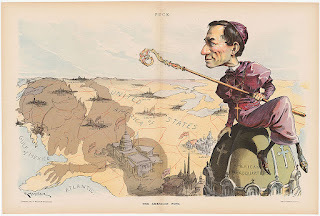
The term travelled across the Atlantic Ocean to the British American Colonies, of course, thus a couple of recent books including the term, Papist Patriots: The Making of American Catholic Identity by Maura Jane Farrelly and Papist Devils: Catholics in British America, 1574-1783 by Robert Emmett Curran. The fear of Papal authority influenced politics throughout the 19th century: the Know-Nothing Party, the State-by-State Constitutional Blaine Amendments, etc.
In 1928, when Al Smith ran for President, he was called a Papist! and we know that in 1960 candidate John F. Kennedy faced, and mollified, to some extent, fears that he would obey the Pope instead of the U.S. Constitution.
It's fascinating to consider how this term "Papist" either as a noun or adjective, has a divisive tradition from the sixteen to the twentieth centuries.
All images public domain:
Top image: William TyndaleBottom image: An anti-Catholic cartoon shows Cardinal Francesco Satolli, who was appointed in 1893 as the first Papal Delegate to the United States, casting a shadow (looking a like Pope Leo XIII) across the country.
"Catholics are . . . not papists but Christians" (Cardinal Müller)
The headline for an exclusive Q&A interview with Cardinal Gerhard Müller begins with the quotation "The Catholic Church is not the Pope’s Church and Catholics are therefore not papists but Christians" as an edited pull quote from a longer sentence in the Cardinal's response to the second question ("What has the Church traditionally taught on the limits of papal authority? ")
. . . The approach to a Catholic ecclesiology is important. In Lumen Gentium, Vatican II did not begin with the Pope because, contrary to what traditional Protestant polemics believed, the Catholic Church is not the Pope’s Church and Catholics are therefore not papists but Christians. Christ is the head of the Church and from Him all divine grace and truth passes to the members of His body, which is the Church. This is also what Vatican II says with the highest authority in the Dogmatic Constitution on Divine Revelation Dei verbum (Art. 10). (emphasis added0Papist is a pejorative term for Catholics: it was commonly used through the long English Reformation and even used when Parliament began passing Acts allowing Catholics more religious freedom (cf ,The Papists Act of 1788, 18 Geo. 3. c. 60). Therefore, I found it interesting that Cardinal Müller used a term so associated in my mind at least with the English Reformation and the long-lasting fear of and prejudice against Catholics in England and her Colonies.
Cardinal Müller is denying that Catholics have ever been Papists. This pejorative term, traditionally used by Protestants against Catholics does not reflect true Catholic identity, according to his answer. We are Christians, not Papists. We should not let others define our identity, based on sixteenth century Protestant tradition handed down through the centuries.
 Its first use as a noun in England occurred in 1528 (as in, "He is a Papist") according to
Merriam-Webster
; as an adjective in 1562 (as in, "He has Papist loyalties").
Its first use as a noun in England occurred in 1528 (as in, "He is a Papist") according to
Merriam-Webster
; as an adjective in 1562 (as in, "He has Papist loyalties"). In 1528, William Tyndale had written and published The Obedience of the Christian Man, which advocated Caesorapapism (the monarch's control of the church in his realm) and the Divine Right of Kings. Anne Boleyn persuaded Henry VIII to read the book and he was influenced by it. In 1532, the Convocation of Bishops agreed to the Submission of the Clergy, abdicating their rights to make ecclesiastical laws to the king and Sir Thomas More resigned as Lord Chancellor, because he would be responsible for enforcing the laws Henry VIII made.
The opposition cited by this term by English Protestants was between the English monarch (Henry VIII, Edward VI, Elizabeth I, James I, Charles I, etc., etc.) and the pope at the time (many popes, from Clement VII, to Pope St. Pius V, to Gregory VIII, to Leo XI, to Blessed Innocent XI, etc., etc.): the issue was: what divided loyalty between secular ruler cum supreme governor of the Church of England and the Pope, the Vicar of Christ, could be allowed on either side?
When Pope St. Pius V excommunicated Queen Elizabeth I and took the further step of declaring English Catholics not bound to loyalty to their monarch (in belated support of the Northern Rebellion) in 1570 (Regnans in Excelsis), he merely intensified the conflict. His successor, Pope Gregory XIII tried to dial it back by separating loyalty and obedience to the Papacy and the Catholic Church in religious matters from loyalty to the monarch and country in civil matters. Although Queen Elizabeth stated that she wanted no window into men's souls, she still wanted their total loyalty, body and soul.
 The Appellants late in Elizabeth I's reign tried to reach an agreement with the queen on the grounds of those separate loyalties, and James I also tried to craft a compromise, but the conflict of loyalties remained. An emblem of these failures would be the martyrdom of Blessed Robert Drury: he was one of the signers of the loyal address of 31 January 1603 which acknowledged the queen as lawful sovereign on earth, but maintained their loyalty in religious matters to the Pope. After the Gunpowder Plot discovery, James I required the Appellants to sign a new oath which acknowledged his authority over spiritual matters. Robert refused, and was arrested in 1606 for the crime of being a priest. He was offered his freedom if he would sign the oath; he declined. Martyred by being hanged, drawn, and quartered on 26 February 1607 at Tyburn, London England. He--and Blessed Roger Cadwallador, another former Appellant signatory, martyred on 27 August 1610--is one of the Eighty-five Martyrs of England and Wales beatified by Saint Pope John Paul II in 1987.
The Appellants late in Elizabeth I's reign tried to reach an agreement with the queen on the grounds of those separate loyalties, and James I also tried to craft a compromise, but the conflict of loyalties remained. An emblem of these failures would be the martyrdom of Blessed Robert Drury: he was one of the signers of the loyal address of 31 January 1603 which acknowledged the queen as lawful sovereign on earth, but maintained their loyalty in religious matters to the Pope. After the Gunpowder Plot discovery, James I required the Appellants to sign a new oath which acknowledged his authority over spiritual matters. Robert refused, and was arrested in 1606 for the crime of being a priest. He was offered his freedom if he would sign the oath; he declined. Martyred by being hanged, drawn, and quartered on 26 February 1607 at Tyburn, London England. He--and Blessed Roger Cadwallador, another former Appellant signatory, martyred on 27 August 1610--is one of the Eighty-five Martyrs of England and Wales beatified by Saint Pope John Paul II in 1987.And a survey of the many martyrs of the long English Reformation shows that it was issue of authority and loyalty between the monarch and the pope at the time that mattered, especially during the early part of Queen Elizabeth's reign, because of Regnans in Excelsis. Nevertheless, most of the missionary priests considered martyrs were found guilty under laws that made it illegal for them to even be present in England, and the laity considered martyrs were found guilty either of assisting the priests, attending Mass, obdurate recusancy (refusal to attend Church of England services), converting to Catholicism, etc. That's why many of the martyrs made statements on the scaffold saying they were loyal to the monarch in all civil martyrs, but followed their consciences to practice the Catholic Faith, especially by celebrating and attending Holy Mass. It is, however, also true that some of these Catholic martyrs upheld the Pope's authority to depose a monarch, although how that would be actionable in sixteenth or seventeenth century England is difficult to see.
We should also note that the Catholic Church would not and has not beatified or canonized any of those priests and laity who were involved in any plot to kidnap, depose, or assassinate a monarch--or blow up Parliament.
Skipping a few centuries, Cardinal Müller also alludes to the Kulturkampf of Chancellor Bismarck in Prussia after the First Vatican Council in 1870:
The German bishops, with the approval of Pope Pius IX, declared to the German Chancellor Bismarck, who wanted to misuse Vatican I to justify the destruction of the Catholic Church in the “Kulturkampf”: “…the infallible magisterium of the Church is bound to the content of Holy Scripture and Tradition as well as to the doctrinal decisions already given by the ecclesiastical magisterium” (Denzinger-Hünermann no. 3116).And we know that Saint John Henry Newman responded to William E. Gladstone's over-reaction to the doctrine of Papal Infallibility in his Letter to the Duke of Norfolk.

The term travelled across the Atlantic Ocean to the British American Colonies, of course, thus a couple of recent books including the term, Papist Patriots: The Making of American Catholic Identity by Maura Jane Farrelly and Papist Devils: Catholics in British America, 1574-1783 by Robert Emmett Curran. The fear of Papal authority influenced politics throughout the 19th century: the Know-Nothing Party, the State-by-State Constitutional Blaine Amendments, etc.
In 1928, when Al Smith ran for President, he was called a Papist!and we know that in 1960 candidate John F. Kennedy faced, and mollified, to some extent, fears that he would obey the Pope instead of the U.S. Constitution.
It's fascinating to consider how this term "Papist" either as a noun or adjective, has a divisive tradition from the sixteen to the twentieth centuries.
All images public domain:
Top image: William TyndaleBottom image: An anti-Catholic cartoon shows Cardinal Francesco Satolli, who was appointed in 1893 as the first Papal Delegate to the United States, casting a shadow (looking a like Pope Leo XIII) across the country.
January 18, 2024
Preview: "Mass Under Penal Laws" on the SRMS
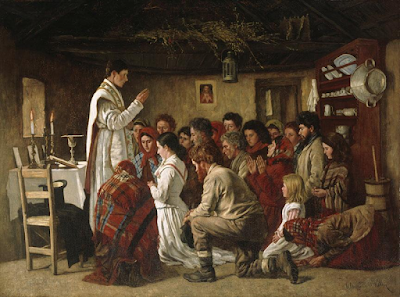
From a Letter of a Missionary Priest:
When a priest comes to their houses, they first salute him as a stranger unknown to them, and then they take him to an inner chamber where an oratory is set up, when all fall on their knees and beg his blessing.
Once the priest reminds them that he will have to leave in morning because of the danger of staying longer, the letter continues:
they all prepare for Confession that evening. The next morning, they hear Mass and receive Holy Communion; then after preaching and giving his blessing the second time, the priest departs, conducted by one of the young gentlemen (that is, of the Catholic Association).
Mention of the Catholic Association helps us date this letter (for which I have not found Father Bowden's source) because this group was established by George Gilbert in the early 1580's when the Jesuit mission to England had begun. That group of young Catholic gentleman, according to Father Bowden's entry for George Gilbert, "was solemnly blessed by Pope Gregory XIII, on April 14, 1580. The members promised to imitate the lives of the Apostles, and to devote themselves wholly to the salvation of souls and the conversion of heretics. They were to be content with the necessaries of their state, and to bestow all the rest for the good of the Catholic cause. They supplied the priests with altar requisites, with horses, and various changes of apparel, and disguised themselves as grooms or servants and escorted the priests through the country from house to house."
The letter goes on:
No one is to be found to complain of the length of the services. If the Mass does not last nearly an hour many are discontented.
The Catholic recusant laity were hungry for the Mass, wanting more and more:
If six, eight, or more Masses are said [Mass was not concelebrated; each priest said Mass separately] in the same place, in the same day (as often happens when when there is a meeting priests), the same congregation will assist at all.
Obviously, the members of the congregation would receive Holy Communion at only one of the Masses, but they wanted to participate in the Sacrifice of the Mass as often as they could when they could.
When they can get priests, they confess every week.
These Catholic communities had to work together for their access to the Sacraments and to assure their mutual safety, so
Quarrels are scarcely known amongst them. Disputes are almost always left to the arbitration of the priests.
And they had to be careful with whom they interacted outside of their communities:
They do not willingly intermarry with heretics [that could mean they wouldn't be able to practice their Catholic faith], not will they pray with them [they were Recusants, not attending Anglican services], nor do they like to have any dealings with them [they probably had to, but that could be dangerous because their recusancy was already known].
The letter does not mention it, but the missionary priests also probably baptized babies and officiated at marriages during these visits too. The recusant laity had to take advantage of these rare and dangerous visits.
Thinking of the first audience for Father Bowden's book in 1910, some of the English Catholics--and many of the Irish Catholics in England--had heard tales of their ancestors during the Penal times. This letter would have revived those shared memories and made them grateful for their greater access to the Sacraments.
In a much milder way, post-COVID lock downs, many of us can appreciate some of that recusant fervor (and some whose TLM opportunities have been repressed can too; I have attended a TLM "house Mass" at least once so far).
Father Bowden selected this verse from Psalm 22 (5):
Thou hast prepared a table before me against them that afflict me. Thou hast anointed my head with oil; and my chalice which inebreatheth me, how goodly is it.
Image Source (Public Domain): Mass in a Connemara Cabin by Aloysius O'Kelly, 1883 (in Ireland)
January 4, 2024
Preview: "Disestablishment" on the Son Rise Morning Show
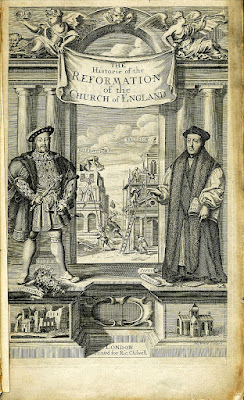 On Monday, January 8, I'll use my first segment of the year of Our Lord 2024 on the Son Rise Morning Show to discuss the Disestablishment Bill introduced in the House of Lords late last year. Either Matt Swaim or Anna Mitchell and I will talk about what this Bill proposes and what it means for England at my usual Son Rise Morning Show time on Mondays, about 6:50 a.m. Central/7:50 a.m. Eastern. Please listen live here or catch the podcast later here: remember you can also watch the hosts on the Son Rise Morning Show as they interview guests, etc, on Facebook and YouTube…!
On Monday, January 8, I'll use my first segment of the year of Our Lord 2024 on the Son Rise Morning Show to discuss the Disestablishment Bill introduced in the House of Lords late last year. Either Matt Swaim or Anna Mitchell and I will talk about what this Bill proposes and what it means for England at my usual Son Rise Morning Show time on Mondays, about 6:50 a.m. Central/7:50 a.m. Eastern. Please listen live here or catch the podcast later here: remember you can also watch the hosts on the Son Rise Morning Show as they interview guests, etc, on Facebook and YouTube…!According to the website of National Secular Society (NSS) on December 6, 2023:
A bill backed by the National Secular Society to disestablish the Church of England has been introduced in parliament.
The private member's bill, proposed by Liberal Democrat peer Paul Scriven with assistance from the NSS, was presented in the House of Lords today.
The bill makes provision for the separation of church and state by removing the Church of England's established status, abolishing the automatic right of bishops to seats in the Lords and removing the monarch's title "Defender of the Faith and Supreme Governor of the Church of England".
It would also give the Church full independence over its doctrine, liturgy, and clergy, while ecclesiastical law and courts would cease to have any legal jurisdiction. The regulation of notaries would also be transferred from the Archbishop of Canterbury to the Lord Chancellor.
Under the bill, the government would set up a committee to oversee these legal changes.
Please note that notaries in England are lawyers; they are not the same as the kind of notaries we have in the USA.
When I first posted about this news, I looked for any reaction from either the Anglican Archbishop of Canterbury or the Catholic Cardinal Archbishop of Westminster, but found none--and still don't find any now. The Humanist UK website--announcing their organization's support for the Bill--does cite a 2018 comment by Justin Welby, the Archbishop of Canterbury:
In an interview with the Guardian, Archbishop of Canterbury Justin Welby has said that disestablishment of the Church of England would not be ‘a disaster’ for the Church, and is ‘a decision for parliament and the people’. He also said that ‘I don’t think [disestablishment] would make it easier [for the Church], and I don’t think it would make it more difficult’.The bill has a long way to go through its stages of reading, revision, passing back and forth between the Houses of Parliament (Lords and Commons), so perhaps that explains the silence so far now. The last step is Royal Assent by King Charles III. If you wish, you may the read the Bill, as introduced, here and track its progress through Parliament here.
This Religion News Service story ties the timing of the Bill's introduction to the Church of England's recent adoption of "Prayers of Love and Faith" for blessings of "same sex couples", which has provoked division in the worldwide Anglican Communion. For Parliament and the Nation, it suggests, that is too little, too late. It also comments that since the Bill wasn't introduced by the Government it has little chance to pass because there won't much action taken.
Re: the division in the worldwide Anglican Communion:
The Kigali Commitment of April 21, 2023, was a shot heard around the world. Thirteen hundred Anglican leaders, dominated by bishops and clergy from the Global South, gathered in Kigali, Rwanda, to declare that they no longer recognized the Archbishop of Canterbury as their leader. Representing 85 percent of the Anglican Communion, they pronounced their determination to “reset the Communion on its biblical foundations.”
So one side, the Archbishop of Canterbury faces, however unlikely, disestablishment, which includes losing his seat in the House of Lords, and on the other, definitely, a vote of no confidence from 85% of the Anglican Communion! What would Henry VIII and Archbishop Cranmer think! (pictured above on the title page of Gilbert Burnet's History of the Reformation of the Church of England.)
The statistics cited by Humanists UK to back the Bill are that:
The recent British Social Attitudes survey demonstrated how unrepresentative our current system is. Only 12% of people consider themselves Anglican. What’s more, 68% of 18-24 years old say they belong to no religion versus 18% saying they are Christian – including only 0.7% saying they are Anglican.The backers of the Bill claim that England has become a more secular society and having an Established Church doesn't make sense.
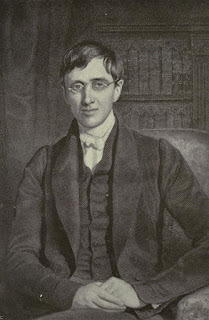 I must admit that I view such issues through the eyes of Saint John Henry Newman. He opposed the re-election of Robert Peel, representative for Oxford in the House of Commons, and Speaker of the House, after the passage of the 1829 Act for Catholic Emancipation. As Wilfred Ward explains in his biography of Newman, Volume 1, Chapter 2:
I must admit that I view such issues through the eyes of Saint John Henry Newman. He opposed the re-election of Robert Peel, representative for Oxford in the House of Commons, and Speaker of the House, after the passage of the 1829 Act for Catholic Emancipation. As Wilfred Ward explains in his biography of Newman, Volume 1, Chapter 2:The occasion for formulating and expressing these views [that "Truths divinely revealed, developed, and explained by men of genius in the past, were preserved by that Church Catholic which was represented in our own country by the Church of England."] was Catholic Emancipation in 1829. Newman had no decided views on the measure itself. But he considered that it was proposed on principles of indifferentism. The Papist was to be tolerated, just as the Socinian was to be tolerated. He regarded it as 'one of the signs of the times,' a sign of the encroachment of philosophism and indifferentism in the Church. When Peel offered himself for re-election, Newman vigorously opposed him, and the opposition was successful. 'We have achieved a glorious victory,' he wrote to his mother on March 1; 'it is the first public event I have been concerned in, and I thank God from my heart both for my cause and its success. We have proved the independence of the Church and of Oxford ... We had the influence of government in unrelenting activity against us and the talent so-called of the University.'
Newman's concern at that time was that the Truth of Revelation be defended in English society and culture and his letters to family, like this one in March of 1829, indicate his ambivalence to the legislation and how it would affect that defense:
I am continuing in fact my letter to my Mother. Well, then, taking the state of parties in the country as it is, I look upon the granting of the Catholic claims not so much in itself as in the principle and sentiments of which it is an indication. It is carried by indifference, and by hostility to the Church. {181} I do not see how this can be denied. Not that it is not a momentous measure in itself; it is certainly an alteration in our Constitution, and, though I am used to think the country has not much to dread from Romanistic opinions (the danger seeming to be on the side of infidelity), yet there is a general impression, which Blanco White's book confirms, that infidelity and Romanism are compatible, or rather connected with each other. Moreover, it is agreed on all hands that the Emancipation will endanger the Irish Protestant Church; some even say it must ultimately fall.
All these things being considered, I am clearly in principle an anti-Catholic; and, if I do not oppose the Emancipation, it is only because I do not think it expedient, perhaps possible, so to do. I do not look for the settlement of difficulties by the measure; they are rather begun by it, and will be settled with the downfall of the Established Church. If, then, I am for Emancipation, it is only that I may take my stand against the foes of the Church on better ground, instead of fighting at a disadvantage.
Newman was already seeing the dangers of the Erastian control of the Church of England in 1829 and of course that would be one of the main themes of the Oxford Movement beginning in 1833, that the Church of England's bishops should be leading, not the Government.
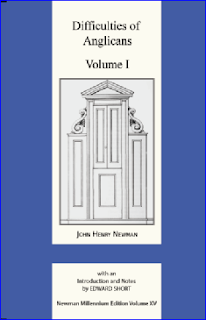 After he had become a [Roman] Catholic and he spoke to "the Religious Movement of 1833" in his 1850 lectures on Anglican Difficulties with Catholic Doctrine, I think Newman had recognized the even greater dangers of that Erastianism to those of his friends who had remained in the Church of England. It was no firm or trustworthy foundation for them to stand upon: In the first lecture "On the Relation of the National Church to the Nation" he warned them:
After he had become a [Roman] Catholic and he spoke to "the Religious Movement of 1833" in his 1850 lectures on Anglican Difficulties with Catholic Doctrine, I think Newman had recognized the even greater dangers of that Erastianism to those of his friends who had remained in the Church of England. It was no firm or trustworthy foundation for them to stand upon: In the first lecture "On the Relation of the National Church to the Nation" he warned them:
I have said all this, my brethren, not in declamation, but to bring out clearly to you, why I cannot feel interest of any kind in the National Church, nor put any trust in it at all from its past history, as if it were, in however narrow a sense, a guardian of orthodoxy. It is as little bound by what it said or did formerly, as this morning's newspaper by its former numbers, except as it is bound by the Law; and while it is upheld by the Law, it will not be weakened by the subtraction of individuals, nor fortified by their continuance. Its life is an Act of Parliament. It will not be able to resist the Arian, Sabellian, or Unitarian heresies now, because Bull or Waterland resisted them a century or two before; nor on the other hand would it be unable to resist them, though its more orthodox theologians were presently to leave it. It will be able to resist them while the State gives the word; it would be unable, when the State forbids it. Elizabeth boasted that she "tuned her pulpits;" Charles forbade discussions on predestination; George on the Holy Trinity; Victoria allows differences on Holy Baptism. While the nation wishes an Establishment, it will remain, whatever individuals are for it or against it; and that which determines its existence will determine its voice. Of course {9} the presence or departure of individuals will be one out of various disturbing causes, which may delay or accelerate by a certain number of years a change in its teaching: but, after all, the change itself depends on events broader and deeper than these; it depends on changes in the nation. As the nation changes its political, so may it change its religious views; the causes which carried the Reform Bill and Free Trade may make short work with orthodoxy.He was warning them that the Erastian Church of England would follow the spirit of the age and the interests of the establishment and that "changes in the nation" would be the source of church teaching, not those "Truths divinely revealed, developed, and explained by men of genius in the past . . ." And he was proved right as we have seen the last century (women priests; women bishops; abortion; contraception, etc). There have been departures in the last century and in this as the Church of England adopted those changes in doctrine and practice, culminating in Pope Benedict XVI's establishment of the Anglican Ordinariate.
Would anything change in the Church of England if this Disestablish Bill became law?
Next week, we'll resume our regular Monday morning segments on Mementoes of the English Martyrs and Confessors by Father Henry Sebastian Bowden, formerly a member of the Church of England before he became a Catholic and an Oratorian priest!



